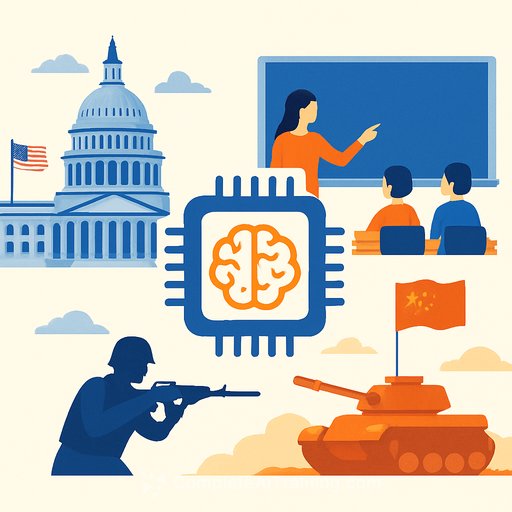AI Is Splitting Higher Education: How to Close the Gap Now
AI is widening gaps between well-funded campuses and institutions that run lean. The difference isn't hype-it's access, fluency, and policy. The fix is practical: align tools, training, and governance around equity and measurable outcomes.
Where the divide shows up
- Infrastructure: Uneven access to compute, licenses, and secure data environments.
- Tool access: Some students use premium AI suites; others rely on free, limited versions-or nothing.
- Faculty readiness: Pockets of expertise alongside widespread uncertainty and time constraints.
- Assessment: AI-blind assignments, unclear rules, and inconsistent enforcement.
- Student equity: Device, bandwidth, and accessibility gaps that compound learning differences.
- Policy and risk: Patchwork guidance on bias, privacy, IP, and data retention.
What this means for your institution
Without a plan, AI advantages cluster around select programs and students, while others fall behind. Expect uneven learning outcomes, integrity incidents, and higher support loads. The solution is structured rollout with clear standards and shared resources.
90-day action plan
- Baseline audit: Map current AI tools, licenses, faculty usage, student access, and data flows. Identify the top three friction points.
- Minimum viable toolset: Approve 2-3 core AI tools for writing, analysis, and accessibility with secure sign-in and logging.
- Faculty sprint: Run a 4-6 week micro-cohort for 30-50 instructors to rebuild one assignment with AI-aware design and rubrics.
- Student AI literacy: Create a required 60-90 minute module on effective prompts, verification, citation, and limits.
- Assessment update: Label courses and assignments as AI-allowed, AI-limited, or AI-restricted with examples and consequences.
- Integrity protocol: Use AI detection as one signal, not a verdict. Require process artifacts (drafts, logs, reflections).
- Data guardrails: Publish a one-page standard on PII, sensitive data, retention, and approved use cases.
- Procurement quick wins: Prefer campus-wide licensing, educational discounts, and LTI/SSO compatibility.
- Funding: Reallocate from low-use software, pursue grants, and pool purchases across departments or consortia.
Policy essentials (clear and short)
- Usage tiers: Define allowed, limited, and restricted contexts with course-level choice and department oversight.
- Equity clause: If an assignment permits AI, provide access or an equivalent pathway for all students.
- Attribution: Require disclosure of AI assistance and the specific tools used, plus sources for factual claims.
- Privacy and IP: No sensitive data in public models; clarify ownership of AI-assisted student work.
- Continuous review: Update each term based on outcomes, incidents, and new capabilities.
Faculty development that sticks
- Time-boxed practice: 90-minute workshops with live course makeovers, not lectures.
- Templates: Provide assignment patterns (research, problem sets, labs) with AI-allowed and AI-restricted variants.
- Peer exemplars: Short case videos from instructors in similar disciplines to speed adoption.
- Micro-credentials: Recognize skill progression and tie it to evaluation or stipends where possible.
Student equity playbook
- Access: Device loaner pools, campus AI labs, and low-bandwidth options for commuters and part-time students.
- Skills: Mandatory AI literacy module plus targeted support for first-year and returning learners.
- Accessibility: Use AI for captions, reading support, and translation-validate outputs for accuracy and bias.
- Advising: Coach students on ethical use, consent, and data footprints tied to their future careers.
Procurement checklist
- Security: SOC 2 or equivalent, data residency options, admin controls, and audit logs.
- Integrations: LMS LTI, SSO, and export to common formats.
- Cost control: Seat sharing, throttling, and usage analytics to prevent sprawl.
- Accessibility: WCAG 2.1 AA, keyboard navigation, and screen reader support.
- Educational terms: Clear student IP terms and non-training clauses for submitted content where needed.
Assessment that reduces misconduct
- Process evidence: Require outlines, drafts, and reasoning traces rather than final outputs alone.
- Oral checkpoints: Short viva or screen-share demos for high-stakes work.
- Variant banks: Parameterized questions or unique datasets by cohort.
- Transparency: Teach acceptable AI use and citation so students don't guess the rules.
What to measure each term
- Access: Percentage of students with approved AI tool access by course and program.
- Use: Faculty adoption rate and number of AI-aware assignments per course.
- Outcomes: Changes in grades, completion, and time-on-task where AI is allowed.
- Equity: Outcome gaps by program, modality, and demographic-then target support.
- Risk: Integrity incidents, data breaches, and policy exceptions with quick remediation.
Helpful references
Staff-ready training options
If you need structured upskilling for faculty and staff, consider curated programs and course maps aligned to education jobs and skills. These can speed consistency and reduce trial-and-error.
Bottom line
The AI divide is fixable with standards, shared access, and skill-building. Start with a baseline, set clear rules, fund common tools, and measure outcomes. Small, fast moves beat big, slow plans.
Your membership also unlocks:






